Chris Vernell
Three score and nineteen
Surely not personal experience?It’s high enough that a fall will likely cause damage. How might i know this?
Surely not personal experience?It’s high enough that a fall will likely cause damage. How might i know this?
Of course not! He just happened to be there when it happened on someone else's railway, and, being a proper gentlemen, is not going to identify the other party.Surely not personal experience?
Totally agree Phil from past and present experience putting adjustable feel straight onto gravel or soil will necessitate constant adjustment as they will sink.If your raised track will have its 'feet' sitting on gravel:
Put a small slab / tile / block-paviour, under the foot to spread the load. - Else they will settle/sink, and you will be forever making adjustments.
PhilP.
Oh no did you have a high crash….. ?Id consider guard rails where appropriate. Just enough to stop / catch a tumble.
While your layout will be on nice level framework, and track work should be great, things happen. Sectional curves that dont fit ‘perfectly’, slight gaps , etc.
String-lining, points, pushing a line of cars, can all lead to derailments. It’s high enough that a fall will likely cause damage. How might i know this?
Jeepers......I will never compalin about red ants in the garden ever againIn Australia some of our white ant (Termites) hills can be well over 6 foot high
View attachment 343191
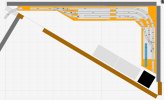
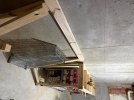
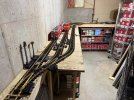
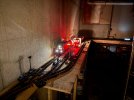

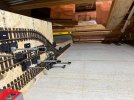
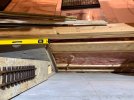
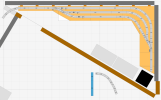
Concrete walls can be a little rough on rolling stock. My track planning software doesn't seem to automatically allow for overhang of long rolling stock. Looking back at your outdoor plan, which I'm assuming is still in the planning stages, you might consider a suggestion I made to DianeTape in her rebuild. https://www.gscalecentral.net/threads/blassen-hugel-gartenbahn.322788/post-766720. JimmyB shows how he did it in his Tumble Down Falls after my post. (I may have gotten the idea from him in the first place.It turns out there is not a comfortable amount of clearance for the large passenger cars on the back curve section.
Also, I am going to add some 1.5" spacers between the wall and decking so that they don't get too close the concrete wall.
View attachment 348830
So I will try to update the track soon and finish adding the two remaining triangle support pieces, but after I have to clean up the mess in the other room so that the wife is happy.

Concrete walls can be a little rough on rolling stock. My track planning software doesn't seem to automatically allow for overhang of long rolling stock. Looking back at your outdoor plan, which I'm assuming is still in the planning stages, you might consider a suggestion I made to DianeTape in her rebuild. https://www.gscalecentral.net/threads/blassen-hugel-gartenbahn.322788/post-766720. JimmyB shows how he did it in his Tumble Down Falls after my post. (I may have gotten the idea from him in the first place.) I've included a suggestion just for the lower left part of your plan. You show all set track, and I cheated a bit by using flex. Aristo Craft doesn't seem to make partial curves in the 20' diameter, at least not in my planning software.
View attachment 348842
My apologies for the links. I think there is a better way to embed them that I haven't discovered yet.
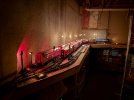
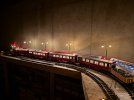


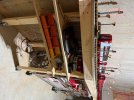
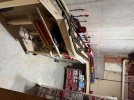
Looking very good, I am very envious of the fleet you have. The lights look fantastic.After a few weeks of travel, I finally found some time to get back to building the storage yard.
I was able to get all the switches and uncouplers wired up, as well as the lights!
I am trying to figure out what kid of shelving slash wall mount structure to put above that I can park the rest of my rolling stock.
I am leaning towards some kind of shelf standing metal shelving unit, so that I do not have to drill into the concrete wall. I am not sure what to do. I only want the shelving to be one track deep so that it does over crowd the storage yard.
What would you add to store the rest of the rolling stock above the yard?
I still need to finish cutting some boards and tidying up the cables, but it is almost done in time for me to start the outside track!
I hope you enjoy them!
View attachment 349909
View attachment 349910
I realized right then that I need to add lighting to the baggage car, Ha.
View attachment 349911
View attachment 349912
And the bench work, I think I am going to keep all the interior switches manual with switch boxes.
View attachment 349913
View attachment 349914
Hm we do not see what is above the line very clearly, in tyenfirst pic there is a tantalising look at what may be wood upper floor joists? If so you could hang down from these with 2x1 inch timber to make a 6or 9 inch shelf to store your stock. The metal free standing units are likely to be as wide as your boards detracting from the layout look a lot.After a few weeks of travel, I finally found some time to get back to building the storage yard.
I was able to get all the switches and uncouplers wired up, as well as the lights!
I am trying to figure out what kid of shelving slash wall mount structure to put above that I can park the rest of my rolling stock.
I am leaning towards some kind of shelf standing metal shelving unit, so that I do not have to drill into the concrete wall. I am not sure what to do. I only want the shelving to be one track deep so that it does over crowd the storage yard.
What would you add to store the rest of the rolling stock above the yard?
I still need to finish cutting some boards and tidying up the cables, but it is almost done in time for me to start the outside track!
I hope you enjoy them!
View attachment 349909
View attachment 349910
I realized right then that I need to add lighting to the baggage car, Ha.
View attachment 349911
View attachment 349912
And the bench work, I think I am going to keep all the interior switches manual with switch boxes.
View attachment 349913
View attachment 349914
Hm we do not see what is above the line very clearly, in tyenfirst pic there is a tantalising look at what may be wood upper floor joists? If so you could hang down from these with 2x1 inch timber to make a 6or 9 inch shelf to store your stock. The metal free standing units are likely to be as wide as your boards detracting from the layout look a lot.
Good, link dord not work for UK but sure you could adapt for your needs.Ahh, thanks, that would work well.
There are engineered joists above the yard.
I could hang some metal shelving uprights and attach some Railrax to hold the extra cars.
I have been wanting to try this type of shelving:
